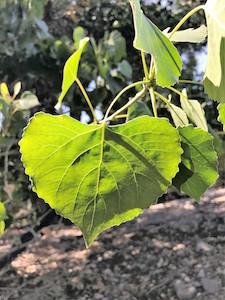 Cottonwood leaf near Hillsboro, NM in September 2017. Although native to our region, cottonwood trees are no longer recommended for most of our ornamental landscapes because of their high water needs. Photo credit M. Thompson.
Cottonwood leaf near Hillsboro, NM in September 2017. Although native to our region, cottonwood trees are no longer recommended for most of our ornamental landscapes because of their high water needs. Photo credit M. Thompson.
Question: How much water does my tree need?
- Multiple Gardeners from All Over New Mexico
Answer: I’ve said it before, and I’ll say it again: It depends! Considerations include the tree species, age, growth phase (e.g., dormant, bud break, leaf senescence in fall, etc.), soil type, time of the year, temperatures, winds, other weather-related events like recent rain, hail, or snow, and so on.
Even if you know the species of your tree and try to look up water requirements, you will likely find either a painfully vague answer like “moderate” or a complicated one. For example, in Judith Phillips’ revised New Mexico Gardener’s Guide the watering directions for desert willow are as follows “Until it reaches the desired height, water to a depth of two to three feet every two weeks when temperatures are above 90 degrees Fahrenheit, especially when the tree is flowering. Water once a month late spring through early fall, and every six weeks or less in winter…” Notice, she does not provide specific amounts of either water quantity or irrigation timing for each irrigation event. This is partly due to the variability of water output based on the type of irrigation equipment and water pressure, but also due to the huge variability of water capacity in different soil types. Phillips is also giving away a clue about general root structure, but we will learn more about that in a minute.
In the book Second Nature, Michael Pollan provides an interesting comparison of water holding capacities based on soil type: “100 pounds of sand will hold 25 pounds of water, 100 pounds of clay will hold 50 pounds of water, and 100 pounds of humus will hold 190 pounds of water. A soil rich in compost will need less watering, and the plants growing in it will better withstand drought”. This is not to suggest that soil amendments, like compost, are beneficial when planting trees in New Mexico – in fact, many arborists recommend zero soil amendment in the planting hole to discourage roots from growing only in that small, amended area. Using Pollan’s soil comparisons, imagine what will happen to 5 gallons of water if applied to sandy soil versus clay. The water will infiltrate deeper in the sandy soil and wider in the clay soil. So how much water you need to apply around your desert willow, as well as the rate you apply it, depends on the soil type. The USDA NRCS Web Soil Survey is a great online resource for finding your exact soil type, and I have added a quick tutorial on how to navigate that website tool on my blog: NMSUdesertblooms.blogspot.com (type “web soil survey” in the blog search prompt).
When I first read Phillips’ water recommendations for different species, I wondered how I could figure out how deep the water is moving in my soil. One way to do this is to get a t-shaped rebar tool and push it down into the soil. The rebar tip will move easily in moist soil and stop when it reaches dry soil. Many gardeners use a screwdriver to test soil moisture up to the length of the blade, so that is one easy place to start. Judy Nickell, a veteran Master Gardener in Bernalillo County, recommends the long, narrow-bladed shovel for moving a wedge of soil just enough to check soil moisture depth when you are establishing your watering routine and when you suspect a problem.
This is key: roots will not grow through dry soil to find a water source. You read that right! Roots grow where the soil is moist. Therefore, when you are irrigating, it is crucial to apply water both where the roots currently are in the soil as well as where you want them to grow.
Somewhere along the way, most of us picked up the wrong idea for the shape of tree root structures. That mental image of the underground root mass mirroring the above-ground shape of the tree canopy is not accurate. Root systems often extend two to four times the height of a given tree, if given the opportunity. Moreover, an estimated 90% of tree roots that are actively absorbing water and nutrients can be found in the top three feet of soil and 75% in the top foot.
Next week, check back for a discussion on irrigation needs based on tree species, age, canopy size, and more.
For more gardening information, visit the NMSU Extension Horticulture page at Desert Blooms.
Send gardening questions to Southwest Yard and Garden - Attn: Dr. Marisa Thompson at desertblooms@nmsu.edu.
Please copy your County Extension Agent and indicate your county of residence when you submit your question!


